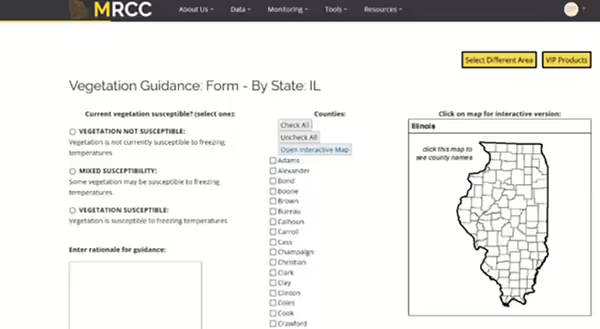
As we get closer to this year’s growing season, it’s important to remember that the changes to the climate are also affecting local weather patterns and planting dates. There are many climate tools available for anyone growing gardens, crops, specialty crops, and landscapes through the Midwest Regional Climate Center, the USDA Midwest Climate Hub, Drought.gov, and the Illinois Water and Atmospheric Monitoring program.
One tool I’d like to focus on is the Vegetation Impact Program, which was created by the Climate Hub and Midwest Regional Climate Center. This is a monitoring, assessment, and networking program that uses online climate monitoring information and stakeholder input to provide resources that can help minimize negative vegetation impacts, mitigate climate variability effects, and develop adaptation plans to better prepare for extreme and ever-changing environmental conditions.
Some of the tools included:
- Freeze Maps: A dashboard monitoring current season freezes, growing degree days, and vegetation status.
- Freeze Date Tool: Freezing temperature date information from the north-central and northeastern U.S.
- Freeze Probabilities: Explore the likelihood of the temperature dropping to freezing or below freezing, which constitutes a "freeze event."
- Custom Chilling Hours Tool: Track chilling hour accumulations across the U.S. using customized temperature thresholds and time periods.
- Stress Degree Days: All plants have an optimum range of temperatures for growth, and Stress Degree Days are a way of tracking how much stress a type of plant has been subjected to within its growing season.
Another part of the Vegetation Impact Program website is Freeze Guidance. The Midwestern Regional Climate Center collaborates with weather forecasters, university Extension specialists, state climatologists, and other vegetation experts to improve communication about the state of vegetation and its susceptibility to potentially damaging low-air temperatures.
Climatological maps of first and last freeze events are helpful to know when to expect these events, but these do not fully capture the current season’s conditions. Freeze Guidance Reports allow forecasters to effectively communicate the threat of frost and freeze events, which triggers alerts to the public to provide the opportunity for preventative actions such as bringing plants indoors, covering vulnerable plants, or activating heaters.
Weather forecasters and local vegetation observers are welcome to submit Freeze Guidance Reports. For a frost or freeze forecast to be beneficial, forecasters need to have the best guidance possible on the state of the vegetative and climatological environment.
Those who submit reports also have access to other Freeze Guidance Report submissions, archived Freeze Guidance Reports, and the Freeze Guidance Member List.
For more information or to get started for reporting Freeze Guidance reports, visit the Midwest Regional Climate Center website.
About the Blog
The All About Weather blog by Duane Friend explores the environment, climate, and weather topics for Illinois. Get in-depth information about things your weather app doesn't cover, from summer droughts to shifting weather patterns. Never miss a new post!